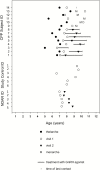The Relationship Between Estrogen and the Decline in Delta Power During Adolescence
- PMID: 28364433
- PMCID: PMC5806564
- DOI: 10.1093/sleep/zsx008
The Relationship Between Estrogen and the Decline in Delta Power During Adolescence
Abstract
Study objectives: During adolescence, there is a precipitous decrease in slow-wave sleep (SWS) and its spectral correlate, delta power, which may reflect cortical reorganization. The temporal association between the decrease in delta power and puberty suggests that sex steroids may initiate these changes. This association has not been previously investigated.
Methods: To determine whether estrogen triggers the adolescent decline in delta power, we compared delta power in 14 girls with central precocious puberty (CPP) and 6 age-matched, prepubertal controls. Five CPP participants were re-studied 7-14 months after pubertal suppression to determine if the changes in delta power are reversible after restoring a prepubertal hormonal milieu. The change in delta power was also compared between CPP participants and five historic controls from a longitudinal polysomnographic study.
Results: CPP participants (6.7-10.5 years) spent 30% of the night in SWS. Delta power (3.7 × 106 ± 2.7 × 105 µV2) predominated in the first 2 non-rapid eye movement episodes and decayed exponentially (tau 0.006 minutes). Age-matched controls demonstrated similar sleep staging (24% SWS) and delta dynamics (3.3 × 106 ± 5.1 × 105 µV2, tau 0.004 minutes). Four out of 5 CPP participants had a significant decrease (26%) in delta power after hormone suppression (p < .05), similar to historic controls.
Conclusion: Using an innovative model of girls with CPP studied before and after estrogen suppression, the effects of puberty on the decline in delta power were dissociated from those of chronologic age. The current studies suggest that increased estrogen does not cause the adolescent decline in delta power and indicate that neurodevelopmental changes per se or other factors associated with puberty drive these sleep changes.
Keywords: central precocious puberty; sex steroids; slow-wave activity; slow-wave sleep.
Published by Oxford University Press on behalf of Sleep Research Society (SRS) 2017. This work is written by (a) US Government employee(s) and is in the public domain in the US.
Figures




Similar articles
-
Basal luteinizing hormone/follicle stimulating hormone ratio in diagnosis of central precocious puberty.J Med Assoc Thai. 2003 Jun;86 Suppl 2:S145-51. J Med Assoc Thai. 2003. PMID: 12929982
-
Serum insulin-like growth factor I (IGF-I) and IGF-binding protein 3 levels are increased in central precocious puberty: effects of two different treatment regimens with gonadotropin-releasing hormone agonists, without or in combination with an antiandrogen (cyproterone acetate).J Clin Endocrinol Metab. 1995 Oct;80(10):3059-67. doi: 10.1210/jcem.80.10.7559897. J Clin Endocrinol Metab. 1995. PMID: 7559897 Clinical Trial.
-
Adequacy of a single unstimulated luteinizing hormone level to diagnose central precocious puberty in girls.Pediatrics. 2009 Jun;123(6):e1059-63. doi: 10.1542/peds.2008-1180. Pediatrics. 2009. PMID: 19482738
-
Disorders of Puberty: An Approach to Diagnosis and Management.Am Fam Physician. 2017 Nov 1;96(9):590-599. Am Fam Physician. 2017. PMID: 29094880 Review.
-
[Physiology of pubertal maturation].Pediatr Med Chir. 1992 Jul-Aug;14(4):375-9. Pediatr Med Chir. 1992. PMID: 1461775 Review. Italian.
Cited by
-
Orexin and Alzheimer's Disease: A New Perspective.Psychiatry Investig. 2020 Jul;17(7):621-626. doi: 10.30773/pi.2020.0136. Epub 2020 Jun 11. Psychiatry Investig. 2020. PMID: 32517419 Free PMC article.
-
Analysis and 15-Year Projections of the Global Burden of Tension-Type Headache by Sex from 1990 to 2021: A Systematic Review of GBD 2021 Data.J Pain Res. 2025 Jul 10;18:3505-3517. doi: 10.2147/JPR.S512335. eCollection 2025. J Pain Res. 2025. PMID: 40667532 Free PMC article.
-
Sleep Timing in Patients with Precocious and Delayed Pubertal Development.Clocks Sleep. 2019 Feb 16;1(1):140-150. doi: 10.3390/clockssleep1010013. eCollection 2019 Mar. Clocks Sleep. 2019. PMID: 33089160 Free PMC article.
-
Sleep and Puberty.Curr Opin Endocr Metab Res. 2021 Apr;17:1-7. doi: 10.1016/j.coemr.2020.09.009. Epub 2020 Oct 9. Curr Opin Endocr Metab Res. 2021. PMID: 35005296 Free PMC article.
-
Longitudinal Analysis of Sleep Spindle Maturation from Childhood through Late Adolescence.J Neurosci. 2021 May 12;41(19):4253-4261. doi: 10.1523/JNEUROSCI.2370-20.2021. Epub 2021 Mar 30. J Neurosci. 2021. PMID: 33785642 Free PMC article.
References
-
- Boyar R, Finkelstein J, Roffwarg H, Kapen S, Weitzman E, Hellman L. Synchronization of augmented luteinizing hormone secretion with sleep during puberty. N Engl J Med. 1972; 287(12): 582–586. - PubMed
-
- Feinberg I. Schizophrenia: caused by a fault in programmed synaptic elimination during adolescence? J Psychiatr Res. 1982; 17(4): 319–334. - PubMed
MeSH terms
Substances
Grants and funding
LinkOut - more resources
Full Text Sources
Other Literature Sources
Medical

